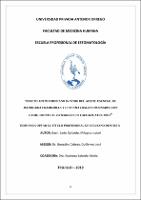Mostrar el registro sencillo del ítem
Efecto antimicrobiano in vitro del aceite esencial de matricaria chamomilla y cúrcuma longa combinados con CAOH2 frente al enterococcus faecalis atcc 29212
| dc.contributor.advisor | González Cabeza, Guillermo José | |
| dc.contributor.author | León Gallardo, Milagros Isabel | |
| dc.creator | León Gallardo, Milagros Isabel | |
| dc.date.accessioned | 2019-04-30T16:42:38Z | |
| dc.date.available | 2019-04-30T16:42:38Z | |
| dc.date.issued | 2019 | |
| dc.identifier.uri | https://hdl.handle.net/20.500.12759/4730 | |
| dc.description.abstract | Comparar el efecto antimicrobiano in vitro del aceite esencial de Matricaria chamomilla y Curcuma longa embebidos con CaOH 2 frente al Enterococcus faecalis ATCC 29212. Material y Método: El estudio fue longitudinal, comparativo y experimental; cada aceite esencial estuvo conformado por 3 repeticiones para el ensayo de espectrofotometría la muestra fue de 152 tubos y para el ensayo de difusión fue de 24 placas. Para determinar la eficacia atimicrobiana de cada aceite esencial se decidió usar 7 diferentes concentraciones : 100%, 50%, 25%, 12,5%, 6,25%, 3,13% y 1,56% además del grupo control ( Agua destilada + hidróxido de calcio). Para la comparación del efecto se aplicaron las pruebas estadísticas Anova y Duncan. Resultado: El efecto antimicrobiano de las combinaciones de los aceites esenciales con CaOH 2 a traves de los dos metódos se observó que por espectrofotometría las concentraciones mas resaltantes fueron al 100 % (0.73 nm), 25%( 0.95nm) y 3,13% (1.60 nm) del aceite de Matricaria chamomilla. Y por el método de difusión, según Duncan las concentraciones ubicadas en el primer grupo fueron: al 100% (1.43 mm) del aceite de Curcuma longa, al 100% (1,67 mm) del aceite de Matricaria chamomilla y el grupo control (CaOH 2 + agua destilada) (1.53 mm). Conclusión: El aceite esencial de Matricaria chamomilla al combinado con hidróxido de calcio fue la más eficaz . | es_PE |
| dc.description.abstract | To compare the in vitro antimicrobial effect of the essential oil of Matricaria chamomilla and Curcuma longa embedded with CaOH2 against Enterococcus faecalis ATCC 29212. Material and Method: The study was longitudinal, comparative and experimental; each essential oil consisted of 3 repetitions for the spectrophotometry test the sample was 152 tubes and for the diffusion test was 24 plates. To determine the atimicrobial efficacy of each essential oil, it was decided to use 7 different concentrations: 100%, 50%, 25%, 12.5%, 6.25%, 3.13% and 1.56% in addition to the control group (Water distilled + calcium hydroxide). For the comparison of the effect, the Anova and Duncan statistical tests were applied. Result: The antimicrobial effect of the combinations of essential oils with CaOH2 through the two methods showed that by spectrophotometry the most outstanding concentrations were 100% (0.73 nm), 25% (0.95nm) and 3.13% ( 1.60 nm) of Matricaria chamomilla oil. And by the diffusion method, according to Duncan, the concentrations located in the first group were: 100% (1.43 mm) of the Curcuma longa oil, 100% (1.67 mm) of the Matricaria chamomilla oil and the control group ( CaOH2 + distilled water) (1.53 mm). Conclusion: The essential oil of Matricaria chamomilla when combined with calcium hydroxide was the most effective | en_US |
| dc.description.uri | Tesis | es_PE |
| dc.format | application/pdf | es_PE |
| dc.language.iso | spa | es_PE |
| dc.publisher | Universidad Privada Antenor Orrego - UPAO | es_PE |
| dc.relation.ispartofseries | T_ESTO_579 | |
| dc.rights | info:eu-repo/semantics/openAccess | es_PE |
| dc.source | Universidad Privada Antenor Orrego | es_PE |
| dc.source | Repositorio institucional - UPAO | es_PE |
| dc.subject | Enterococcus faecalis | es_PE |
| dc.subject | Matricaria chamomilla | es_PE |
| dc.title | Efecto antimicrobiano in vitro del aceite esencial de matricaria chamomilla y cúrcuma longa combinados con CAOH2 frente al enterococcus faecalis atcc 29212 | es_PE |
| dc.type | info:eu-repo/semantics/bachelorThesis | es_PE |
| thesis.degree.level | Título Profesional | es_PE |
| thesis.degree.grantor | Universidad Privada Antenor Orrego. Facultad de Medicina Humana | es_PE |
| thesis.degree.name | Cirujano Dentista | es_PE |
| thesis.degree.discipline | Estomatología | es_PE |
Ficheros en el ítem
Este ítem aparece en la(s) siguiente(s) colección(es)
-
Estomatología [567]

